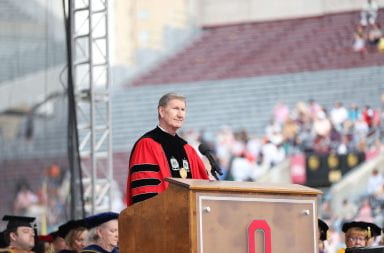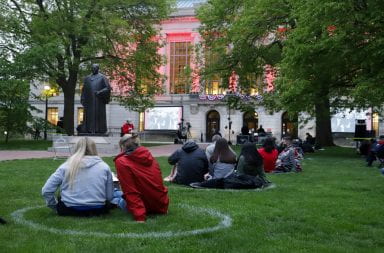
] Students can still find ways to stay physically fit while recreation facilities are closed. Credit: Courtesy of the Office of Student Life Marketing
The World Health Organization recommends that the average person get 2.5 hours of moderate or 1.5 hours of intense exercise every week, but with campus recreation facilities closed due to COVID-19, students might be confused as to how to maintain their health and fitness.
The university’s closure does not have to be the end of a student’s fitness routine and students are still capable of finding new and creative ways to work out, Alice Adams, group fitness programming and education manager in the Department of Recreational Sports, said.
“I think that it definitely is still possible to keep a really solid fitness regimen going because at the end of the day, it’s just about moving, no matter how you’re moving,” she said.
Adams said that even simple activities, such as cleaning a bedroom, count in adding movement to a daily routine. She said walking outside and getting fresh air is a great way to improve both physical and mental health, especially after staying in one place all day.
Working out from home is a way for students who are used to gym equipment to change up their fitness routines and focus on diversifying their training through bodyweight exercises and cardio, Adams said.
Adams cited squats, lunges, pushups, mountain climbers, planks and high knees as good beginner bodyweight exercises.
Adams said time at home can also present an opportunity for students who don’t work out to begin experimenting with fitness, especially if they are intimidated by going to the gym.
When it comes to constructing a routine, Adams stressed regularity and exercising in intervals. She said it’s best to incorporate “movement breaks” into one’s existing schedule.
“What has helped me is to find normalcy and routine where I can, so if I normally wake up at a certain time and have my coffee and listen to a podcast, keep doing that,” she said. “But maybe incorporate a few more breaks for myself.”
While sports teams have canceled seasons and team practices, Adams said athletes can still exercise and focus on technical skills by holding virtual practices together.
“If you’re someone who really loves team sports, what is it that you love about it and how can you recreate those opportunities maybe just in a different way? If you love to sweat and move, maybe it’s doing one of those bodyweight exercises,” she said.
Adams said Recreational Sports is creating a number of virtual resources for students, including a series of YouTube videos called #LifeInMotion at Home, which demonstrates ways students can stay active at home, and the #BuckeyesMove social media campaign, which has a daily exercise challenge for students to take part in.
Aside from physical fitness needs, students should also pay attention to what their bodies are telling them about their nutritional and dietary needs, as many students who are now staying at home will face changes in their activity levels, Janele Bayless, wellness coordinator for nutrition education in the Student Wellness Center, said.
“My biggest encouragement would be to tune into their bodies’ needs,” she said. “That way, they’re not just on autopilot, but really tuning into when they’re hungry throughout the day and also tuning into their mental and emotional needs.”
Bayless said students should consider their reasons for eating, whether it be out of hunger, boredom, stress or another reason, and pay attention to when they’re eating during the day.
“If food is fuel, I would encourage people to spread their food intake out throughout the day. Sometimes we’re consuming a lot more in one sitting, and if people are sitting all day they don’t need to be consuming as much in one sitting,” she said.
Bayless said it is always important for students to get a balanced mix of all three macronutrient groups – carbohydrates, fats and proteins – because each serves important purposes in the body.
According to Wellness Center resources, carbohydrates are largely acquired through sugars and starches such as bread, pasta and potatoes, and they provide the majority of the body’s required energy. Fats come from foods such as oils, butter and nuts. They are responsible for transferring vitamins and storing energy. Proteins — found in meat, eggs, dairy and beans — are responsible for growing and maintaining cells and tissues.
Bayless said that because students tend to turn toward sugary foods — which result in an excess of carbohydrates — they should strive to create structured meals with a balance of the food groups.
For students who want to remain active while at home, Bayless said there are endless online options for health and exercise tips and workout programs, including on YouTube, fitness apps and social media. She said even playing a game like Wii Sports is a great way to stay active at home.
Bayless said many campus resources — including nutrition and wellness coaching — are still continuing to help students virtually. The Buckeye Peer Access Line, a nonemergency student helpline, will continue operating during its regular hours of Monday through Friday from 8 p.m. to midnight. Buckeye Food Alliance, a student-run, on-campus food pantry, will continue to operate out of its Lincoln Tower location with modified hours. She said the wellness center website also has resources to help students plan nutritious, balanced meals.
Bayless said that, along with maintaining physical health, students should pay attention to their mental health and make choices that will benefit them emotionally, especially in this time of change.
“This is a really unique time that most people haven’t experienced,” she said. “Our mental and emotional needs are just as important as our physical ones.”


